

Cebu might move at a slower pace than Manila, but it doesn’t lag behind in charm or opportunity. Known as the Queen City of the South, it’s where city living meets island life. One day you’re at a beach in Mactan, the next you’re grabbing coffee in a sleek IT Park café or exploring the mountains of Busay.
For expats, freelancers, and remote workers, Cebu offers an easy-going lifestyle with lower costs, great connectivity, and the ocean always within reach. The cost of living depends on how you want to experience it. You can choose from a budget apartment near downtown Cebu, a modern condo in IT Park, or a sea-view flat in Mactan are all within reach.
Read also: The best digital nomad jobs in the Philippines
Finding a place to live in Cebu is all about deciding your pace: city energy or coastal calm. The city has grown into one of the Philippines’ most dynamic hubs, blending modern living with easy access to beaches and nature.
Rent varies depending on the area. Modern condos near Cebu IT Park and Lahug are pricier, while more local neighbourhoods around Mandaue or Talamban offer good value. Many properties come fully furnished and include amenities like pools, gyms, and 24-hour security.
The heart of modern Cebu. These areas attract professionals and digital nomads with high-speed internet, coworking spaces, cafés, and restaurants. It’s central, convenient, safe, and the most popular choice for expats.
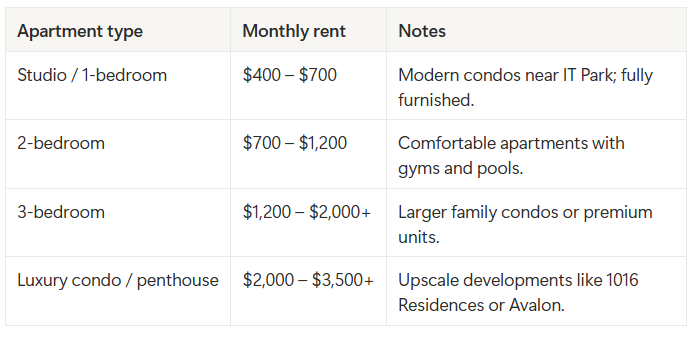
Perfect for those who love ocean views and resort-style living. Mactan combines city access with beach proximity, making it ideal for expats working remotely.

This is a balanced option, close to schools, malls, and the city centre but with quieter surroundings. Great for families or long-term expats looking for more space and greenery.

Ideal for those on a tighter budget or seeking a more local feel. These areas are farther from the main business districts but offer good transport links and affordable rents.

Cebu is easier to navigate than Manila, but traffic can still surprise you during rush hour — especially around IT Park, Mandaue, and the bridges to Mactan. The city blends island calm with urban bustle, and most expats quickly find their rhythm using a mix of taxis, ride-hailing apps, jeepneys, and motorbikes.
Taxis
Taxis are common in Cebu City and a reliable way to get around. They’re metered, affordable, and safer when booked through apps or hotel desks.
Ride-hailing apps (Grab, Angkas)
Grab is the go-to app for expats and travellers — offering car, taxi, and food delivery services. Angkas (for motorbike rides) is also popular for beating traffic in busy areas.
Jeepneys
Cebu’s colourful jeepneys are everywhere and remain the cheapest way to get around. Routes cover the whole city, though figuring them out takes a little practice.
Buses
Cebu’s bus routes mostly connect the city to neighbouring areas like Mactan, Liloan, and Talisay. Within the city, MyBus and P2P routes are air-conditioned and convenient for daily commutes.
Motorbikes and scooters
Cebu’s compact size makes scooters a favourite for locals and long-stay expats. You can rent, buy, or book a ride through apps like Angkas or JoyRide.
Car rentals / driving
Driving in Cebu gives you freedom to explore beyond the city — beaches, waterfalls, and mountain spots are just hours away. Traffic can get heavy near bridges and city centres, but roads are generally better than in Manila.
Ferries and island hopping
One unique perk of Cebu life — you can hop on a ferry and be on another island in an hour. Regular ferries and fast crafts connect Cebu to Bohol, Negros, and nearby islands.
Walking and cycling
Cebu is compact enough for short walks in safe areas like IT Park or Cebu Business Park. Cycling is becoming more common, with new lanes and rental options.
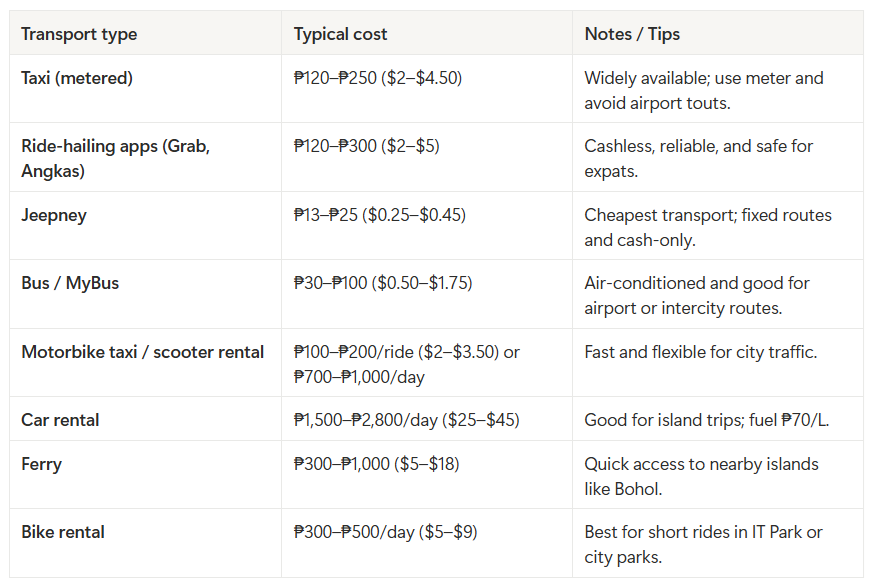
Cebu is a city that feeds both your appetite and your curiosity — where street stalls, seaside grills, and trendy cafés coexist in perfect balance. The food scene is as diverse as the island itself: Filipino comfort classics, fresh seafood, and international flavours all within reach.
Restaurants
Eating out in Cebu can be as affordable or indulgent as you like. You can grab a plate of lechon or pancit from a local eatery for a few dollars or sit down to a fusion meal overlooking the sea.
Cafés are a big part of Cebu life — perfect for remote work or weekend brunches. Expect to pay ₱200–₱350 ($3.50–$6) for a latte and pastry in popular spots like IT Park or Banilad.
Supermarkets and markets
Groceries in Cebu are affordable, especially if you mix shopping between supermarkets and palengkes (wet markets). Imported goods are pricier, but local produce, meat, and seafood are fresh and inexpensive.

Many expats in Cebu do a mix: buying seafood and fruit at local markets, then stocking up on pantry items and imported food at Landers or SM. The city’s coastal location means seafood — tuna, shrimp, and squid — is often fresher and cheaper than in Manila.
Here’s a realistic monthly breakdown in USD:
For one person
Total monthly food budget: $320–560
Enough to cook most meals at home, dine out a few times a week, and still enjoy Cebu’s food scene — from lechon stalls to seaside cafés.
For a couple or small family
Total monthly food budget: $640–1,000
That covers a nice mix of home cooking, local dining, and the occasional weekend splurge at a resort or high-end restaurant in Mactan.
Cebu’s utility costs are similar to Manila’s, though slightly lower in some areas. Electricity remains the biggest expense, especially if you rely on air conditioning to get through the humid months. Most modern condos include basic amenities like water and internet, but it’s always worth confirming what’s covered in your rent.
Electricity
Electricity costs in Cebu can vary depending on the building and how much you use the AC. The local provider, Visayan Electric (VECO), charges rates comparable to those in Metro Manila.
Water
Water is generally affordable and provided by the Metropolitan Cebu Water District (MCWD). Most condos and apartments charge minimal monthly rates, though houses may have separate billing.
Gas
Most households in Cebu use LPG tanks for cooking. These are easy to order from local suppliers and usually delivered within the day.
Internet
Internet in Cebu is reliable, with fibre connections widely available in urban areas. It’s fast enough for remote work, video calls, and streaming.
Mobile/Cell phone
Mobile data is affordable and widely used. Most expats choose prepaid SIM cards, which are simple to top up online or through convenience stores.
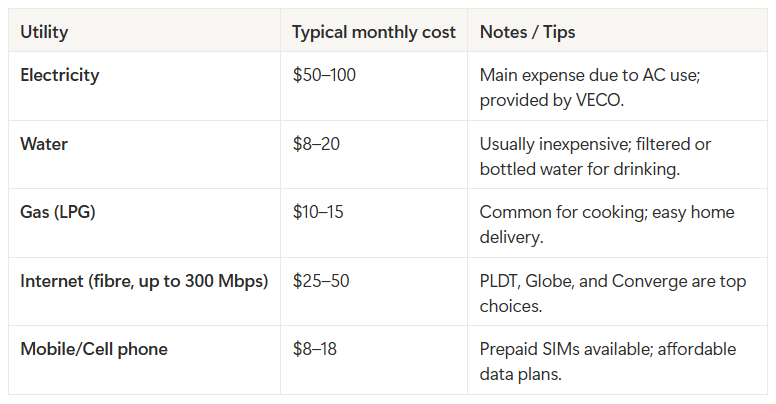
Cebu’s healthcare system offers a balance between affordability and quality, with a good mix of public hospitals and private facilities that cater to both locals and expats. The city is known for its reliable medical infrastructure, modern private hospitals, and English-speaking healthcare professionals.
Public healthcare
Public healthcare in Cebu is managed under the national system of the Department of Health (DOH) and supported by PhilHealth, the government’s health insurance programme. Public hospitals are inexpensive and accessible but often busy, especially during peak hours.
Public healthcare is a decent option for minor illnesses or emergencies, but most expats prefer private hospitals for better service, shorter waiting times, and modern facilities.
Private healthcare and insurance
Cebu has several excellent private hospitals offering international-quality care at affordable prices compared to Western standards. Facilities such as Cebu Doctors’ University Hospital, Chong Hua Hospital, and Perpetual Succour Hospital are well regarded for their modern equipment, specialised departments, and English-speaking staff.
Private health insurance is recommended for expats, digital nomads, and long-term residents. Both local and international providers offer a range of plans suitable for healthcare in Cebu and nationwide. Leading insurers include AXA Philippines, Pacific Cross, Allianz, and Cigna Global.
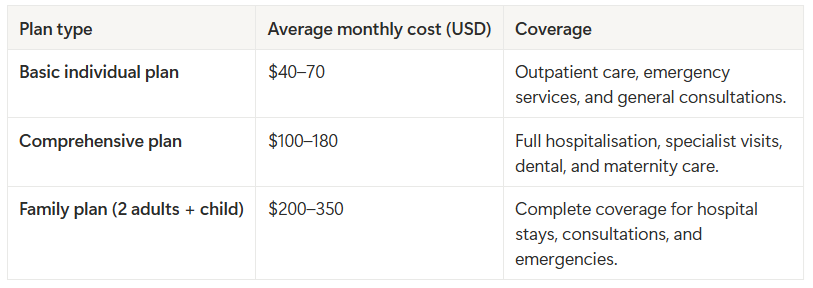
Cebu blends the rhythm of city life with the calm of island living. It’s more relaxed than Manila but just as dynamic, with coworking cafés, mountain getaways, and beaches never too far away. The cost of living is slightly lower than in the capital, making it an appealing choice for expats, freelancers, and remote workers looking for balance.
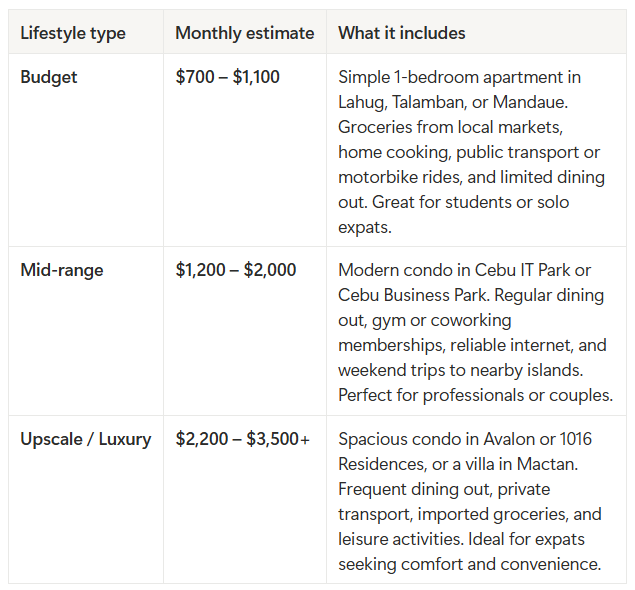
You can live comfortably in Cebu for around $1,000–1,600 per month, depending on your lifestyle and location. Local markets, affordable dining, and easy access to nature make it easy to live well without overspending.
Cebu proves that living well doesn’t have to cost a fortune. From affordable apartments to delicious meals, you can enjoy a comfortable lifestyle without stretching your wallet.
With Grey, you can receive international payments in USD, GBP, or EUR, convert when exchange rates are best, and withdraw PHP directly to a Philippine bank account. It’s fast, secure, and designed for global citizens who live and work across borders.
Open a free Grey account to make life in Cebu simpler and stress-free.

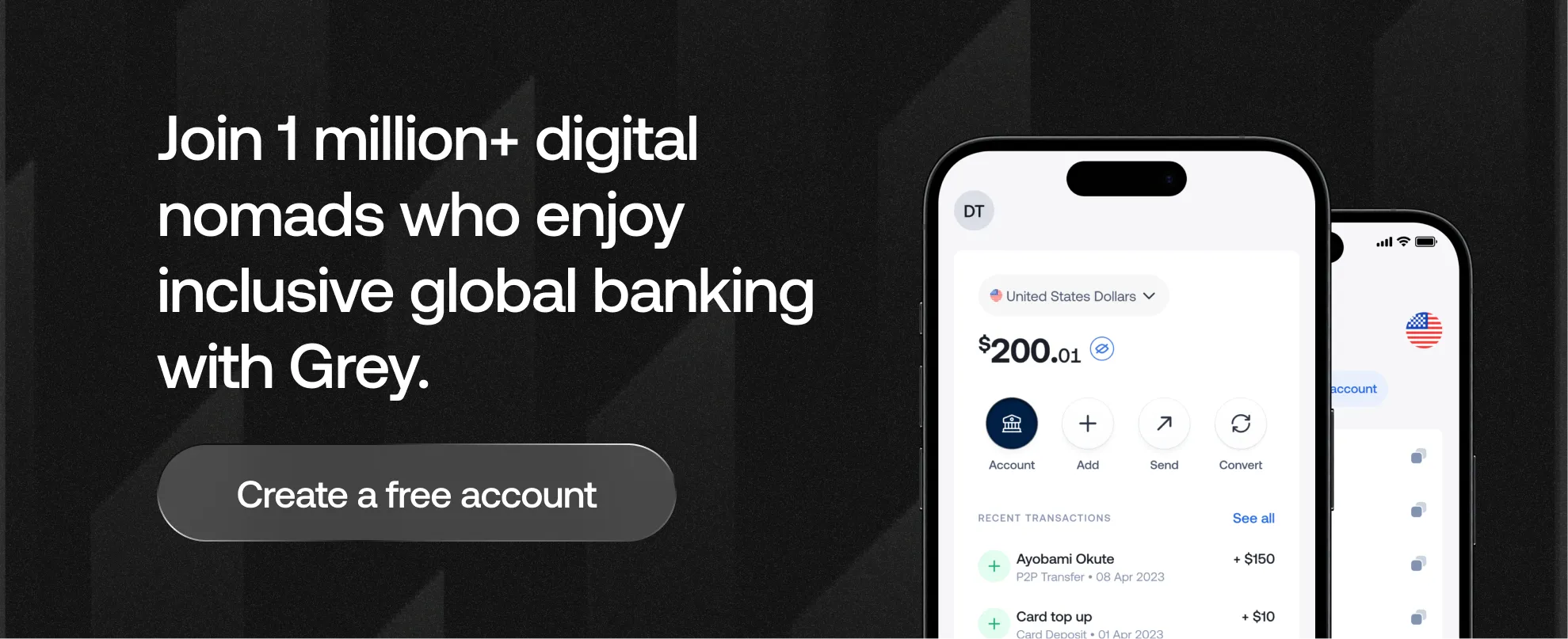


.svg)
Back to top